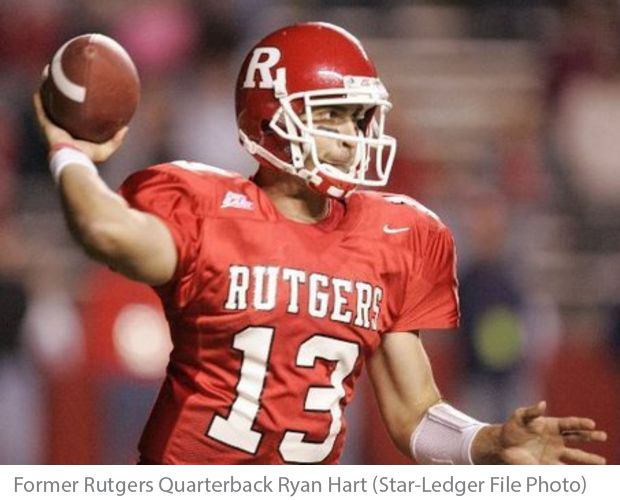Rutgers Quarterback Victorious Against EA Sports
 Ryan Hart is the former starting quarterback for Rutgers University. In addition to setting a number of school records and leading his team to its first bowl appearance since 1978, Hart has added a victory in the courtroom against Electronic Arts ("EA") to his list of accomplishments. In their NCAA Football series, EA Sports provides users with a realistic gameplay experience. Part of this realistic experience is characters that resemble real-life players. So when a player chooses Rutgers, the quarterback is number 13, is 6'2", weighs 197 pounds, and appears wearing a visor and an armband on his left wrist—the resemblance to Ryan Hart is nearly exact. In October of 2009, Hart filed suit against EA Sports for violating his right of publicity by using his appearance in the game.
Ryan Hart is the former starting quarterback for Rutgers University. In addition to setting a number of school records and leading his team to its first bowl appearance since 1978, Hart has added a victory in the courtroom against Electronic Arts ("EA") to his list of accomplishments. In their NCAA Football series, EA Sports provides users with a realistic gameplay experience. Part of this realistic experience is characters that resemble real-life players. So when a player chooses Rutgers, the quarterback is number 13, is 6'2", weighs 197 pounds, and appears wearing a visor and an armband on his left wrist—the resemblance to Ryan Hart is nearly exact. In October of 2009, Hart filed suit against EA Sports for violating his right of publicity by using his appearance in the game.
The right of publicity is a right that each person has that protects against the use an individual's identity – a name, identity, likeness, etc. – for commercial purposes without the individual's consent. Each state has its own right of publicity laws, but an individual does not need to be a public figure or a celebrity to enforce the right. Basically, if someone's image is taken for a commercial use without consent, then there could be a claim for infringing the right of publicity – even for use in a video game!
The use of a college athlete's likeness was problematic for the Third Circuit. College athletes are required to be amateurs and cannot be compensated for the use of their likeness. Additionally, video games fall under the protection of the First Amendment and freedom of speech. The court accordingly looked for a test to balance free speech with the rights of publicity.
A court can look to the "Predominant Use Test," which looks to whether the product predominantly exploits the commercial value of a person's identity. The court rejected this test as "subjective at best [and] arbitrary at worst." It then looked to the "Rogers Test," which is a trademark-based test that evaluates the relationship between the celebrity image and the work as a whole. The court found that the Rogers Test would legalize broad swaths of tortious activity and rejected its use.
The court found its solution in the "Transformative Use Test" — a copyright-based test — to resolve the conflicts between the EA's First Amendment rights and Hart's publicity rights. Essentially, the test requires "significant transformative elements" in order to avoid violating a person's right of publicity. Because EA Sports did little if any transformative work to Hart's in-game image, the court ruled in Hart's favor. It was careful to note that the video game was still subject to First Amendment protection, but that Hart's personal publicity rights outweighed constitutional protection in this case. If the reasoning of the Third Circuit becomes accepted nationally, video game producers may have to change how they portray their collegiate athletes in order to satisfy the Transformative Use Test.
Categories: Copyright, Personal Publicity Rights
Posted by: Michael C. Zarht (Summer Associate)
Amanda J. Dernovshek
T: 517.371.8259
F: 517.371.8200
adernovshek@fosterswift.com
Taylor A. Gast
T: 517.371.8238
F: 517.371.8200
tgast@fosterswift.com
Lindsey M. Mead
T: 517.371.8326
F: 517.371.8200
lmead@fosterswift.com
Categories
- Privacy
- Startup
- Sales/Disputes
- Copyright
- Compliance
- News
- Elder Law
- Entity Selection, Organization & Planning
- Criminal
- Legislative Updates
- Venture Capital/Funding
- Alerts and Updates
- Contracts
- Chapter 11
- Financing
- Technology
- Electronic Health Records
- Digital Assets
- Sales Tax
- Trademarks
- Personal Publicity Rights
- Artificial Intelligence (AI)
- Intellectual Property
- E-Commerce
- Regulations
- Trade Secrets
- Employee Benefits
- Hospitals
- Cybersecurity
- National Labor Relations Board
- Crowdfunding
- Mergers & Acquisitions
- Patents
- Lawsuit
- Domain Name Registration
- Tax Disputes
- Tax
- Inspirational
- Insurance
- Distribution
- Employment
- IT Contracts
- Estate Planning
- Defamation
- Social Media
- Hospice
- HIPAA
- Retirement
- Licensing
- Department of Labor
- Did you Know?
- Corporate Transparency Act (CTA)
- Labor Relations
- Entity Planning
- Liability
- Fraud & Abuse
- Billing/Payment
- Cloud Computing



 Share
Share